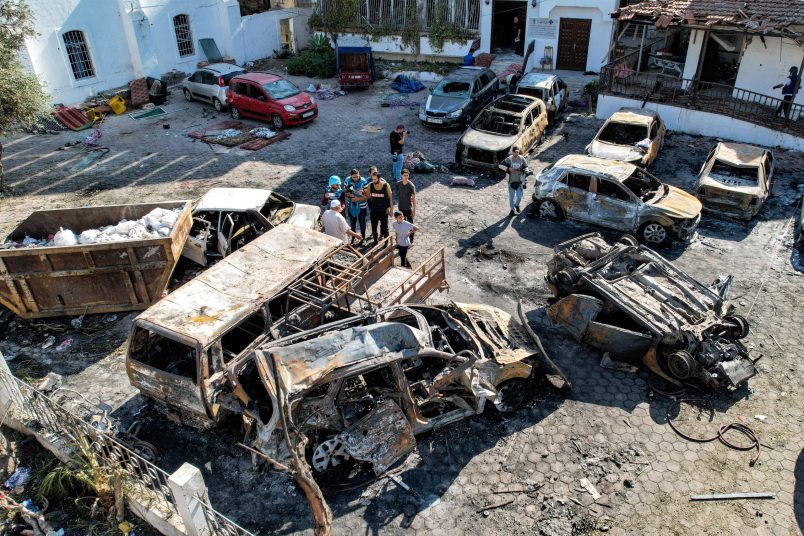I have no ability to evaluate grainy videos or make sense of what different blast patterns look like. But I’ve spent several years developing lists of open source intelligence and forensics analysts who are consistently credible. You’ve seen some of this in the various Twitter lists I sometimes post here. Credible doesn’t mean always right, of course. By credible in this case I mean analysts who are highly knowledgeable in one relevant domain, use an empirical framework for analyzing videos, open source data, etc., and have a proven track record of the appropriate level of caution and skepticism in drawing conclusions. Many of these people come out of the Bellingcat world, others got started (at least publicly) analyzing the Syrian and Ukraine conflicts. It’s actually remarkable what people not drawing on any state or property “intelligence” can demonstrate with overlapping provenance-proven video evidence, geolocation, satellite photography, open source weapons information, tracking data and more.
I watched this group very closely overnight (even at the expense of not getting much sleep) as more videos and data emerged about the hospital blast in Gaza and from what I can tell none of these people think the evidence points to an Israeli bomb as the source of the blast.
They’re not all saying it’s open and shut. In fact, I’m not sure any of them are saying that. That’s a very high standard. But every one that I follow is saying the weight of evidence points to some version of a failed rocket launch from within Gaza. And they’re saying that with varying degrees of certainty.
Significantly, several different kinds of evidence appear to point to this same conclusion — nighttime video of the explosion, audio analysis of the sounds immediately prior to the blast, day after photographs of the impact site and blast zone, et al. Israel has published what it says is audio of Hamas operatives discussing the blast and ascribing it to the failed Islamic Jihad rocket launch. I don’t disbelieve that audio because it fits with the other evidence. But I place it in a separate category because a lot of people are going to be inherently skeptical of any evidence coming from one of the interested parties. All the evidence discussed above is from photographs and videos from international news organizations. Indeed, the key blast video, I believe, comes from a Hamas-run TV station.
I’m not looking at whatever comes over the transom and generated by whatever algorithm. I’m only looking at sources and experts who I had experience with prior to the conflict.
One interesting example of this analysis is tied to the photo at the top of this post. I’ll just speak generally since I’m no expert. I’m just summarizing. (Here is some more detail in a larger thread. Here’s video from Tass of the hospital the morning after.) But if you look, there’s a small crater at the center of this parking lot. The cars right next to it are totally demolished. But cars just no more than twenty or thirty feet away have no more than blown out windows and some are almost totally unscathed. To a trained eye that suggests a relatively small blast.
With daybreak there are growing questions about whether the blast was of the magnitude reported last night and whether the alleged number of fatalities can be accurate. Unlike the ‘who did this’ question, this analysis seems less clear to me. If I’m understanding the discussion it seems like the actual blast as opposed to the subsequent fire was fairly small and much of the blasted building is actually intact. But I’d recommend looking at the discussion yourself and drawing your own conclusions.
One red flag last night is that there were almost instant, very large and very round fatality numbers. The two I saw circulating in global media, based on the accounts from the Gazan (Hamas) health ministry, was either 200-300 or 500 dead. It’s almost impossible to actually count numbers of dead and wounded that quickly. So at best those were estimates in a highly chaotic situation. But while most global media showed some caution about who was responsible, these death counts were reported more or less as fact. It’s possible they’ll prove to be accurate. But there’s significant skepticism about whether what’s visible in daylight squares with those immediate claims. I don’t know what numbers of fatalities are credible, just that credible analysts are skeptical of those original estimates.
In case it isn’t clear. This isn’t a booyah! conclusion. This doesn’t change the fact that an estimated three thousand people have died in Gaza during this war. But as best as I can tell this is what people who have a proven track record of credibility in those earlier conflicts (as opposed to people popping up in algorithms) are saying as of this morning.
If you’re interested in reading some of this stuff yourself a lot of it comes from my list of military analysts tracking the Ukraine War. There’s also my list of reporters tracking events in Israel. There’s also this list of open source intelligence analysts which I look at, but I am not the curator of. That list is a bit more raw however. So I’d be more cautious with it.
Generally, if you dip into this stuff, don’t take any one analysis as the one that settles it. Look at the weight of an opinion, whether it seems to point clearly in one direction or another. Also, run towards expressions of caution and away from expressions of certainty.


 Member Newsletter
Member Newsletter
